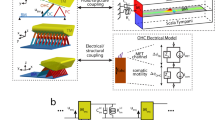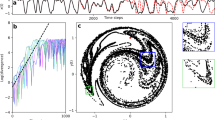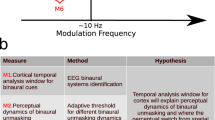Abstract
THEinner ear sometimes acts as a robust sound generator, continuously broadcasting sounds (spontaneous otoacoustic emissions) which can be intense enough to be heard by other individuals standing nearby1–4. Paradoxically, most individuals are unaware of the sounds generated within their ears. Two hypotheses could explain this paradox: (1) the spontaneous emissions may not be transmitted to the central nervous system; or (2) the spontaneous emission produces a continuous, high rate of neural activity, which, like the natural pattern of spontaneous activity, is ignored by the central nervous system. Here we demonstrate that high-intensity spontaneous otoacoustic emissions can vigorously activate auditory nerve fibres in mammals (Chinchilla laniger). This 'internal biological noise' creates a Mine busy' signal that significantly degrades a neuron's ability to respond to sound and results in a hearing loss completely different from that caused by damage to sensory cells1,4.
This is a preview of subscription content, access via your institution
Access options
Subscribe to this journal
Receive 51 print issues and online access
$199.00 per year
only $3.90 per issue
Buy this article
- Purchase on Springer Link
- Instant access to full article PDF
Prices may be subject to local taxes which are calculated during checkout
Similar content being viewed by others
References
Wilson, J. P. & Sutton, G. J. in Tinnitus (eds Evered, D. & Lawrenson, G.) 82–97 (Pitman, London, 1981).
Kemp, D. T. J. acoust. Soc. Am. 64, 1386–1391 (1978).
Zurek, P. J. acoust. Soc. Am. 69, 514–523 (1981).
Ruggero, M. A., Kramek, B. & Rich, N. C. Hear. Res. 13, 293–296 (1984).
Zurek, P. M. & Clark, W. W. J. Acoust. Soc. Am. 70, 446–450 (1981).
Wilson, J. P. Hear. Res. 2, 233–252 (1980).
Zurek, P. M. & Clark, W. W. J. acoust. Soc. Am. 72, 774–780 (1982).
Subramaniam, M., Salvi, R. J., Spongr, V. P., Henderson, D. & Powers, N. L. Hear. Res. 74, 204–216 (1994).
Brownell, W. E., Bader, C. R., Bertrand, D. & de Ribaupierre. Y. Science 227, 194–196 (1985).
Ashmore, J. F. J. Physiol., Lond. 388, 323–347 (1987).
Dieler, R., Shehata-Dieler, W. & Brownell, W. J. Neurocyt. 20, 637–653 (1991).
McFadden, D. & Plattsmier, H. S. J. acoust. Soc. Am. 76, 443–448 (1984).
Dallos, P. & Cheatham, M. A. J. acoust. Soc. Am. 60, 510–512 (1976).
Evans, E. F., Wilson, J. P. & Borerwe, T. A. in Tinnitus (eds Evered, D. & Lawrenson, G.) 108–139 (Pitman, London, 1981).
Nedzelnitsky, V. J. acoust. Soc. Am. 68, 1676–1689 (1980).
Spoendin, H. Acta otolar. 73, 235–248 (1972).
Clark, W. W., Kim, D. O., Zurek, P. M. & Bohne, B. A. Hear. Res. 16, 299–314 (1984).
Salvi, R. J., Perry, J., Hamernik, R. P. & Henderson, D. in New Perspectives on Noise-Induced Hearing Loss (eds Hamernik, R. P., Henderson, D. & Salvi, R. J.) 165–188 (Raven, New York, 1982).
Liberman, M. C. Science 217, 1239–1241 (1982).
Liberman, M. C., Dodds, L. W. & Learson, D. A. in Basic and Applied Aspects of Noise-Induced Hearing Loss (eds Salvi, R. J., Henderson, D., Hamernik, R. P. & Colletti, V.) 163–177 (Plenum, New York, 1986).
Schmiedt, R. A., Zwislocki, J. J. & Hamernik, R. P. J. Neurophysiol. 43, 1367–1389 (1980).
Powers, N. thesis. SUNY at Buffalo (1991).
Sachs, M. B. & Kiang, N. Y.-S. J. acoust. Soc. Am. 43, 1120–1128 (1968).
Kiang, N. Y.-S., Watanabe, E. C. Thomas, L. F. & Clark, L. F. Discharge Patterns of Single Fibers in the Cat's Auditory Nerve (MIT Press, Cambridge. 1965).
Sinex, D. G. & Havey, D. C. Hear. Res. 13, 285–292 (1984).
Sinex, D. G. & Havey, D. C. J. Neurosci. 56, 1763–1780 (1986).
Kiang, N. Y.-S., Moxon, E. C. & Levine, R. A. in Sensorineural Hearing Loss (ed. Wolstenholme G. E. W. & Knight, J. 241–272 (Churchill, London, 1970).
Froymovich, O., Rebala, V., Salvi, R. J. & Rassael, H. J. acoust. Soc. Am. 97, 3021–3029 (1995).
Eldredge, D., Miller, J. D. & Bonne, B. A. J. acoust. Soc. Am. 69, 1091–1095 (1981).
Lonsbury-Martin, B. L., Harris, F., Stagner, B. B. Hawkins, M. D. & Martin, G. K. Ann. Otol. Rhinol. Lar. 99, 15–29 (1990).
Author information
Authors and Affiliations
Rights and permissions
About this article
Cite this article
Powers, N., Salvi, R., Wang, J. et al. Elevation of auditory thresholds by spontaneous cochlear oscillations. Nature 375, 585–587 (1995). https://doi.org/10.1038/375585a0
Received:
Accepted:
Issue Date:
DOI: https://doi.org/10.1038/375585a0
This article is cited by
-
Profiles of Stimulus-Frequency Otoacoustic Emissions from 0.5 to 20 kHz in Humans
Journal of the Association for Research in Otolaryngology (2017)
-
Effects of Contralateral Acoustic Stimulation on Spontaneous Otoacoustic Emissions and Hearing Threshold Fine Structure
Journal of the Association for Research in Otolaryngology (2014)
-
Spontaneous Basilar Membrane Oscillation and Otoacoustic Emission at 15 kHz in a Guinea Pig
Journal of the Association for Research in Otolaryngology (2004)
Comments
By submitting a comment you agree to abide by our Terms and Community Guidelines. If you find something abusive or that does not comply with our terms or guidelines please flag it as inappropriate.



